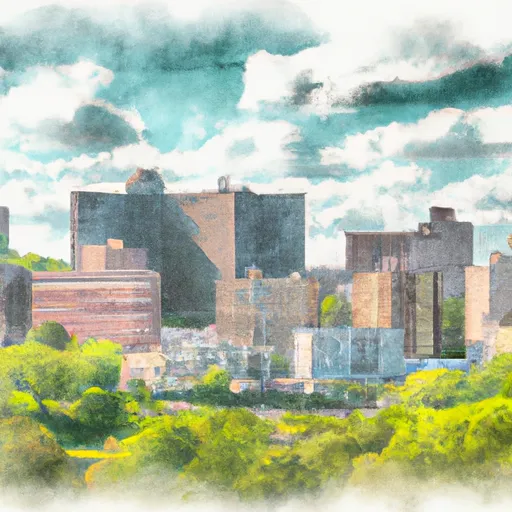-
 Snoflo Premium
Snoflo Premium
Get unlimited access to all our content
With no Ad interruptions! - Start Your Free Trial Login with existing account
Youngstown
Eden Index
Climate
7.6
•
Recreation
3.8
•
Community
3.2
•
Safeguard
5.2/10

Youngstown, Pennsylvania is a charming town located in the northeastern part of the state. The climate in Youngstown is classified as humid continental, characterized by warm summers and cold winters. Summers are mild with temperatures ranging from 70 to 80 degrees Fahrenheit, while winters can be chilly, with temperatures ranging from 20 to 30 degrees Fahrenheit.
The town is blessed with numerous hydrological constituents, including the Mahoning River, which runs through the heart of the city. This river offers opportunities for boating, fishing, and other water activities. Additionally, Mill Creek Park is located nearby, featuring a beautiful lake, creeks, and waterfalls, providing further opportunities for outdoor recreation.
Youngstown boasts a variety of outdoor recreation opportunities. Mill Creek Park offers extensive hiking and biking trails, picnicking areas, and even golf courses. The park also hosts various events and programs throughout the year, including concerts and nature walks. Additionally, nearby lakes and rivers provide opportunities for boating, kayaking, fishing, and swimming.
In summary, Youngstown, Pennsylvania offers a favorable climate with distinct seasons. With its abundance of hydrological constituents and the natural beauty of Mill Creek Park, the town provides ample opportunities for outdoor enthusiasts to engage in a wide range of activities and enjoy the natural surroundings.
What is the Eden Index?
The Snoflo Eden Index serves as a comprehensive rating system for regions, evaluating their desirability through a holistic assessment of climate health, outdoor recreation opportunities, and natural disaster risk, acknowledging the profound impact of these factors on livability and well-being.
Climate Health Indicator (CHI): 7.6
Youngstown receives approximately
1259mm of rain per year,
with humidity levels near 83%
and air temperatures averaging around
10°C.
Youngstown has a plant hardyness factor of
6, meaning
plants and agriculture in this region thrive during a short period during spring and early summer. Most
plants will die off during the colder winter months.
By considering the ideal temperature range, reliable water supplies, clean air, and stable seasonal rain or snowpacks, the Climate Health Indicator (CHI) underscores the significance of a healthy climate as the foundation for quality living.
A healthy climate is paramount for ensuring a high quality of life and livability in a region, fostering both physical well-being and environmental harmony. This can be characterized by ideal temperatures, reliable access to water supplies, clean air, and consistent seasonal rain or snowpacks.
Weather Forecast
Streamflow Conditions
Allegheny
Area Rivers
Allegheny
Snowpack Depths
Allegheny
Reservoir Storage Capacity
Allegheny
Groundwater Levels
Recreational Opportunity Index (ROI): 3.8
The Recreational Opportunity Index (ROI) recognizes the value of outdoor recreational options, such as parks, hiking trails, camping sites, and fishing spots, while acknowledging that climate plays a pivotal role in ensuring the comfort and consistency of these experiences.
Access to outdoor recreational opportunities, encompassing activities such as parks, hiking, camping, and fishing, is crucial for overall well-being, and the climate plays a pivotal role in enabling and enhancing these experiences, ensuring that individuals can engage in nature-based activities comfortably and consistently.
Camping Areas
| Campground | Campsites | Reservations | Toilets | Showers | Elevation |
|---|---|---|---|---|---|
| Blackwater Falls State Park | None | 3,112 ft | |||
| Lost Land Run - Potomac State Forest | 6 | 2,367 ft | |||
| Wallman/Laurel Run - Potomac State Forest | 16 | 2,171 ft | |||
| Swallow Falls State Park | 65 | 2,418 ft | |||
| Deep Creek Lake State Park | 112 | 2,583 ft | |||
| Kentuck - Ohiopyle State Park | 200 | 1,558 ft | |||
| Outflow - Youghiogheny River Lake | 63 | 1,329 ft | |||
| Tub Run Rec Area - Youghiogheny River Lake | 101 | 1,583 ft | |||
| Savage River State Forest Dispersed | 52 | 2,403 ft | |||
| Mill Run - Youghiogheny River Lake | None | 1,565 ft |
Nearby Ski Areas
Catastrophe Safeguard Index (CSI):
The Catastrophe Safeguard Index (CSI) recognizes that natural disaster risk, encompassing floods, fires, hurricanes, and tornadoes, can drastically affect safety and the overall appeal of an area.
The level of natural disaster risk in a region significantly affects safety and the overall livability, with climate change amplifying these risks by potentially increasing the frequency and intensity of events like floods, fires, hurricanes, and tornadoes, thereby posing substantial challenges to community resilience and well-being.
Community Resilience Indicator (CRI): 3.2
The Community Resilience Indicator (CRI) recognizes that education, healthcare, and socioeconomics are crucial to the well-being of a region. The CRI acknowledges the profound impact of these elements on residents' overall quality of life. By evaluating educational resources, healthcare accessibility, and economic inclusivity, the index captures the essential aspects that contribute to a thriving community, fostering resident satisfaction, equity, and social cohesion.

